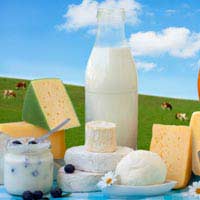Eating for Healthy Bones

Bones might seem to be solid, but they are actually made up of a spongy network of calcium, and they are constantly being broken down and reformed. In children and teenagers, more bone is deposited than ‘withdrawn’, as the skeleton grows. It’s important to eat well and exercise throughout childhood to make bones as strong as possible, as most of the skeleton’s bone mass is formed in the early or mid twenties, and peak bone mass is achieved at around 30.
Calcium
Calcium is the mineral that makes up bones, and is the most common mineral I the body. It’s very important for growing children to have plenty of calcium as they grow. Calcium is found in dairy products, including milk, cheese and yogurt, and these also provide protein and energy, as well as vitamins and minerals. Other sources of calcium include fortified foods including rice milk, soya milk, fruit juices, cereals or bread, tofu, dark green leafy vegetables, broccoli, sesame seeds, pulses, beans and lentils, dried fruit, almonds, oranges and tinned fish with bones, such as salmon and sardines.Babies up to one year should have breast or formula milk as their main drink, but can have full fat cow’s milk added to their food. Children can have full-fat cow’s milk as their main drink until two years old, and then can switch to semi-skimmed milk at two and skimmed at five.
As children grow, they will start to want drinks other than milk, but it’s a good idea to make sure that they have a drink of milk every day – perhaps as a warm bedtime drink, or in a milkshake or smoothie (but watch out for sugar levels). Mixing extra dried milk into sauces or soft food like mashed potato, or making soup with milk rather than water, can help to get extra calcium into the diet.
Drinking too many fizzy drinks that contain high levels of phosphate can reduce the levels of calcium in the bones. Too much caffeine and salt can also affect the calcium levels in the body.
Vitamin D
Vitamin D is also important for healthy bones because it helps the body absorb calcium. Foods containing vitamin D include dairy products, oily fish, fortified cereals, and margarine and other spreads. Vitamin D is also produced in the skin, and just ten to 15 minutes of sun exposure a week provides enough vitamin D.Being a Role Model
It’s important for parents to act as role models where healthy eating and taking in plenty of calcium and vitamin D is concerned – children, especially younger children, will copy what their parents do and learn from them.What Else Affects Bones?
Smoking may reduce the absorption of calcium, and weight-bearing exercise improves bone density.What Happens…
…if children don’t get enough calcium or vitamin D as they grow? They can develop rickets (softening of bones), brittle bones or bones that don’t grow evenly, and can be at risk of osteoporosis in adulthood. There are reported to be significantly more fractures in children and young people than two generations ago, and this may be because they are less active, drink more fizzy drinks, and don’t drink as much milk.- Are Nuts Healthy?
- Healthy Eating to Avoid Diabetes
- Why It's Good to Eat as a Family
- Why is Breakfast Important?
- Drinking Water: Why and How Much?
- The Correct Food Portion Sizes for Kids
- Milk Intolerance in Children
- When Your Child is Diagnosed With a Failure To Thrive
- From Breast to Bottle
- When and How to Wean Your Baby
- Bottle Feeding Your Baby
- Breast Feeding Your Baby

Re: Superfoods on a Budget
I just checked out these fantastic tips for buying superfoods on a budget! Eating healthy doesn’t have to be expensive. Can’t wait to try…
Re: Fun Facts: How Many Calories Does a Child Burn?
hi, im eleven yrs. I weigh about 100 lbs and believe I am over the normal weight. I am about 4’10 ft. I…
Re: Fun Facts: How Many Calories Does a Child Burn?
I want to clear this up for everybody worried about their weight, especially at a young age you shouldn’t…
Re: Dealing with a Child that is Always Hungry
I am the great grandmother of an 8 year old that I mostly take care of her mom is around but she totally depends…
Re: Fun Facts: How Many Calories Does a Child Burn?
I’m 11 years old and recently got a smart watch. This isn’t a big question but I can’t find how many…
Re: Dealing with a Child that is Always Hungry
I'm immediately suspicious of an article that suggests cereal as a healthy snack. Cereal (especially cereal…
Re: Fun Facts: How Many Calories Does a Child Burn?
How many calories SHOULD an average twelve year old burn daily???
Re: Fun Facts: How Many Calories Does a Child Burn?
I'm 9 years old and I'm trying to set up a health journal but I don't know how many calories I should…
Re: Fun Facts: How Many Calories Does a Child Burn?
Hiw much calories should an average 10 year old burn a day?
Re: Dealing with a Child that is Always Hungry
I’m 16 and my sister is 11 years old 57 inches and weighs 90 pounds she only drinks like 2 or 3 16 ounce bottles…